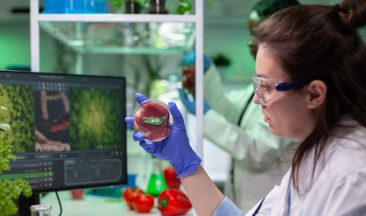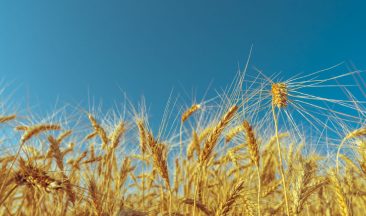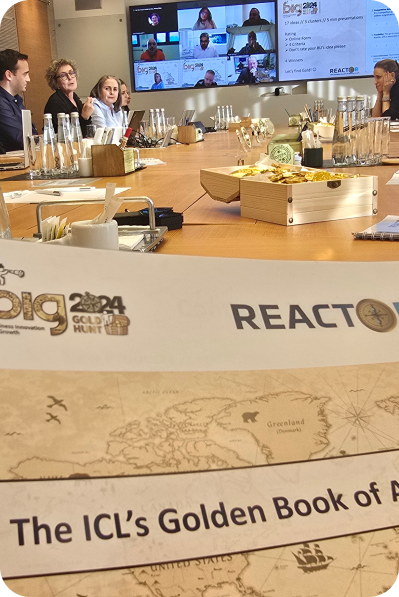Around the world, the best and brightest minds are thinking about the climate on Earth. The changing climate is impacted by decisions – big and small – that set the stage for the future of our world.
One important clue to climate care is carbon footprint: a measure of greenhouse gasses generated by a person, organization, action, or product. Reducing the overall carbon footprint of human activity is crucial; the Earth’s temperature is already a full degree Celsius warmer than it was before the industrial revolution.
In order to protect the climate, the United Nations (UN) has set global goals for net-zero greenhouse gasses by 2050. Individuals and businesses will all be influenced by these goals, and agriculture is no different. In fact, agriculture plays a big role in greenhouse gas emissions and therefore has a big opportunity to address emissions and carbon footprint in the future.
Today, the global agri-food system is estimated to contribute 31% of all human-caused global greenhouse gas emissions. Different crops and production practices influence the carbon footprint in agriculture at different levels.
The Importance of Sustainable Agriculture
Sustainable agriculture practices support agriculture carbon footprint reduction. Understanding the environmental impacts of different production practices can help growers to be intentional about caring for the Earth.
Farming with sustainability in mind also ensures the land will be viable for years to come, continuing to serve as economic support for future generations. Between 2010 and 2050, global food demand is projected to grow by 56%. Sustainable agriculture can ensure food scarcity will not grow as the global population increases.
In short – the benefits of sustainable agriculture are numerous! It can be hard to know where to start with sustainability, or how to reduce carbon footprint in agriculture. These are ten tips for agriculture carbon footprint reduction.
10 Best Practices to Reduce Agriculture Carbon Footprint
- Implement crop rotations to improve soil health
Soil health is influenced by the diversity of plants and microorganisms present. Crop rotations are one way to increase this diversity while reducing disease and pest pressure from years of repeated crop. Rotating the types of crops and crop root depth can support good soil structure while optimizing the use of soil nutrients at different depths. - Implement a 4Rs approach for nutrient management
The 4Rs of nutrient management include: right time, right rate, right source, and right place. The goal of the 4Rs is to keep nutrients where they are needed – on and in the field. Right time means matching the application of nutrients with crop demand. Right rate refers to aligning the amount of fertilizer with crop nutrient uptake. The right source takes into account the type of fertilizer chosen and whether it has an improved efficiency technology such as inhibitors, slow or controlled release. And right place is the precise placement of fertilizer such that crops can successfully access nutrients. - Decrease bare fallow
In many areas of the world, it’s common to leave land unplanted for an entire growing season, especially in semiarid areas. This practice has important environmental downsides and must be avoided. Fossil fuels burned while tilling the soil to control weed, depleted soil organic matter, and increased soil erosion are all negative side effects of bare fallow production practices. - Manage tillage To minimize soil disturbance
While sometimes necessary to reduce soil compaction, tillage should be minimized in order to achieve an agricultural carbon footprint reduction. Tillage requires agricultural machinery such as tractors, which in turn burns fossil fuels. Tillage can also leave soils exposed and prone to erosion. - Sample soil to monitor and manage its health
While soils can give visual clues to their health, soil sampling provides the inside scoop on soil health. Soil tests can report nutrient levels and physical and biological properties. Armed with this information, agronomists, and growers can make educated decisions to support soil and crop health. - Cover crops
Cover crops pack a powerful punch for sustainability. They improve soil organic matter, promote nutrient cycling, can fix N from the air, prevent fields from being fallow, and protect against erosion. - Manage manure amounts and application timing
Remember the 4Rs? When dealing with manure specifically, the rate and timing of application are critical to minimizing runoff and GHG emissions, while keeping crucial nutrients in the soil. - Invest in renewable energy and energy-efficient equipment
Nearly 6% of agriculture’s production emissions come from fuel consumption on the farm. Renewable energy can positively impact their carbon footprint but it can also save farmers money. - Adequate use of fertilizers
Fertilizers play a key role in sustainability and carbon footprint in agriculture. Fertilizers can improve crop yields and crop quality while addressing soil nutrient depletion. Advancements in fertilizer technology, such as controlled release fertilizers and fertigation fertilizers, allow for more precise and efficient use of fertilizers. Both fertilizer technologies allow for an even distribution of nutrients along the crop cycle. They also minimize crop damage from fertilizer burn and reduce nutrient loss into the environment. - Use a data-driven decision support system
Using a data-driven support system to make critical crop protection and nutrient management decisions can ensure the right rates and types of inputs are used on the farm. Data-driven support systems allow growers to compare multiple alternatives, better understand processes, and identify sources of unpredictability. This leads to better use of data and resources to support sustainable agriculture.

How ICL Can Help Reduce the Carbon Footprint in Agriculture
Beyond changing production practices, farmers can turn to solutions with sustainability in mind to determine how to reduce their carbon footprint. Introducing new products and solutions can positively impact greenhouse gas emissions, as well as help grow or maintain yields. Fertilizers, biostimulants, AgTech solutions, and up-and-coming innovations from ICL are all examples of solutions that can help reduce the agricultural carbon footprint.
Fertilizer is any substance that is added to the soil to supply nutrients required by crops. When used adequately in combination with other effective agricultural practices such as irrigation, quality seeds, soil fertility management, etc., fertilizer helps increase crop yield, health, and quality.
Biostimulants support plant nutrition and stimulation throughout the plant life cycle. Soil revitalization, seed treatment, and plant health can also be positively impacted by biostimulants, as they assist with quick recovery from stresses such as drought and heat. Biostimulants can also encourage better root growth and boost soil microbial activity.
AgTech solutions provide innovative, technology-based approaches to solving agriculture’s challenges, such as carbon footprint reduction. AgTech’s goals include increasing crop yield and quality, streamlining processes to drive efficiency, creating local, sustainable agriculture, and providing the ability to adapt to weather and climate-related challenges. AgTech solutions use data, smart sensors, autonomous machines, and AI to support data-based decision-making, crop management, and precise solutions.
There is still so much room for innovation in the agriculture carbon footprint reduction space. RD&I Initiatives for next-generation fertilizers at ICL aim for increased nutrient use efficiency that have better phosphorus and nitrogen uptake, reducing nutrient losses to address the European Green Deal. These fertilizers can also drive focus on commodity fertilizers for acidic and alkaline soils, both in coated and embedded solutions.
Innovation is also key in the area of circular economy recovered and recycled nutrients, specifically for phosphorus and nitrogen. Biodegradable coatings for controlled-release fertilizers, cost-effective slow-release fertilizer granules, organoid-mineral fertilizers, and enhanced efficiency fertilizers all have the opportunity to positively impact agriculture’s carbon footprint.
More on the subject:
ICL’s Employee Carbon Challenge
Sustainability – Not Just Another Catchphrase!
The Role of AgTech in Making Agriculture More Sustainable
Conclusion
Reducing the carbon footprint in agriculture is paramount for managing a warming climate and preventing additional food scarcity as the global population grows. Agriculture is a large contributor to global greenhouse gas emissions, and it will take collaboration across industry, advisors, and farmers to address agriculture’s carbon footprint.
A first step towards meeting the United Nations’ net-zero emissions goal is reducing global greenhouse gas emissions by 45% by 2030. This will keep global warming at no more than 1.5 degrees Celsius. Agriculture is poised to make positive changes that will reduce carbon footprint. How this will take shape depends on changes in the farm level and innovation across the board.
At ICL, not only are we committed to sustainability, but we are continuously working to create innovative solutions to reduce agriculture’s carbon footprint. With controlled release and fertigation fertilizers, biostimulants, AgTech solutions, and up-and-coming innovations, ICL is paving the way for a better and more sustainable future.














